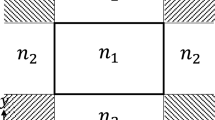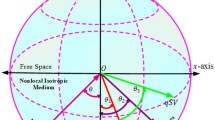Abstract
The nonreciprocal properties of the modes of a backward spin wave in a tangentially magnetized ferrite plate have been investigated. It has been established that ratio R between the normalized amplitudes of the magnetic potential for two waves with the oppositely directed wave vectors oriented at angles φ and φ – π relative to the external magnetic field on the plate surface significantly depends on the φ value. The fR value divides the range of existence of the backward spin waves into two frequency bands: at frequencies below fR, the R(φ) dependence is monotonic (parameter R takes the minimum and maximum values at angles similar to the wave vector cutoff angles) and, at frequencies above fR, there are extreme points (maximum and minimum) at φ values equal the maximum cutoff angles of the surface spin wave. A formula has been derived for the wave vector orientation at which the m-th extreme point lying on one of the plate surfaces arises in the distribution of the amplitude of the magnetic potential of the mth wave mode in the ferrite plate cross section.




Similar content being viewed by others
Notes
An exception is a particular case in which two waves propagate parallel to the external magnetic field in the opposite directions. Only then both waves have identical magnetic potential distributions in the cross section of the ferrite plate and are therefore excited with the same amplitude.
Here, we actually speak about the identical wave excitation geometries.
Briefly, this can be explained as follows. Assuming, for example, in (7), B = 0.86 for the given parameters and φ = 23.9о, we obtain curve 3 in Fig. 2а, for which we have Ψ20(x = 0) = 0.86 at point G. However, to obtain Ψ20(x = s) = –0.86 at φ = –23.9о at point L in curve 6 in Fig. 2b, we have to assume B = 0.298 in (7) (if we retain B = 0.86 at φ = –23.9°, then we obtain Ψ20(x = s) = –2.49 at point L in curve 6 and Ψ20(x = 0) = 0.86 at point H). Thus, the normalization ensures a desired symmetry of the \(\Psi _{0}^{{\text{n}}}(x,\varphi )\) and \(\Psi _{0}^{{\text{n}}}(x, - \varphi )\) curves and the convenience of representation of all the curves in one figure.
The minimum point in curve 5 in Fig. 2b.
Recall that the isofrequency dependence of a wave is the cross section of the dispersion wave surface f(ky, kz) or f(k, φ) by the plane with constant frequency f = const. Since the BSW and SSW isofrequency dependence resemble hyperbolas (see, for example, [17]), then these dependences are characterized by asymptotes. The isofrequency dependence and cutoff angle terms were discussed in more detail in [17] for the SSW and in [21] for the BSW. The frequency dependence of the cutoff angles was obtained first in [24] for the SSW and in [21, 22] for the BSW; unfortunately, there was a misprint in the formula for the BSW cutoff angle (correct formula (32) is presented below).
As was mentioned in [13], the ratio between the potential amplitudes on the ferrite plate surfaces (denoted by α in [13]) is \(\alpha \left( {\overrightarrow { - {{H}_{0}}} } \right) = {{\alpha }^{{ - 1}}}\left( {\overrightarrow {{{H}_{0}}} } \right),\) although the formula for calculating the α value was not given in [13].
In [18], angle \(\varphi _{{{\text{cut1}}}}^{{{\text{SSW}}}}({{f}_{ \bot }})\) described using formula (18), is denoted as αc.
It is assumed here that the linear transducer is an in-phase exciter, which excites a spin wave with the wave vector oriented normally to the transducer line. In reality, this assumption is true only approximately (for more details, see Section 9 in [26]).
In Section 3 of study [16], the loss on excitation (detection) of the useful BSW, according to the power measurements of the transmission coefficient) at f = 2350 MHz, φ = ‒21.5о, and the above-mentioned parameters of the ferrite film was δ = –6.53 dB, while the loss on the excitation of the side BSW (at φ = 159.5о) was δ = –19.43 dB. Then, we find the measured ratio between the amplitudes of two of these waves Rexp = 10–6.53/20/10–19.43/20 = 4.415, which approximately (accurate to ~10%) corresponds to the ratio between the amplitudes of the potential of these two waves R = 4.89 at a specified frequency on surface x = 0 (curves 2 and 5 in Figs. 4b, 4c in [16]). In addition, at φ = 0о, both above-mentioned ratios were equal. Obviously, the ratios between the amplitudes of the useful and side waves can be calculated more accurately by determining the overlap integral for each wave, which will depend on the parameters of the transducer and wave potential distribution over the ferrite plate thickness. However, the calculation of these integrals is beyond our consideration.
REFERENCES
R. W. Damon and J. R. Eshbach, J. Phys. Chem. Solids 19 (3/4), 308 (1961).
B. Lax and K. J. Button, Microwave Ferrites and Ferrimagnetics (McGraw-Hill, New York, 1962; Mir, Moscow, 1965).
G. M. Vapne, “Microwave device on magnetostatic waves,” Obz. Elektron. Tekh., Ser. 1: Elektron. SVCh (Moscow), No. 8(1060), 48−49 (1984).
V. V. Danilov, I. V. Zavislyak, and M. G. Balinskii, Spin Wave Electrodynamics (Libid’, Kiev, 1991).
A. V. Vashkovskii, V. S. Stal’makhov, and Yu. P. Shara-evskii, Magnetostatic Waves in Microwave Electronics (Saratov. Univ., Saratov, 1993) [in Russian].
A. G. Gurevich and G. A. Melkov, Magnetization Oscillations and Waves (Nauka, Moscow, 1994; CRC, Boca Raton, Fl., 1996).
D. D. Stancil and A. Prabhakar, Spin Waves: Theory and applications,Business Media (Springer Science, New York, 2009).
Topics in Applied Physics, Vol. 125: Magnonics: from Fundamentals to Applications, Ed. by S.O. Demokritov and A.N. Slavin (Springer-Verlag, Berlin, 2013).
V. G. Shavrov and V. I. Shcheglov, Magnetostatic Waves in Non-uniform Fields (Fizmatlit, Moscow, 2016).
A. V. Vashkovskii, K. V. Grechushkin, A. V. Stal’makhov, and V. A. Tyulyukin, Pis’ma Zh. Tekh. Fiz. 12, 487 (1986).
A. V. Vashkovskii, A. B. Valyavskii, A. V. Stal’makhov, and V. A. Tyulyukin, Radiotekh. Elektron. (Moscow) 32, 2450 (1987).
A. V. Valyavskii, A. V. Vashkovskii, A. V. Stal’makhov, and V. A. Tyulyukin, Zh. Tekh. Fiz. 59 (6), 51 (1989).
G. A. Vugal’ter and A. G. Korovin, Pis’ma Zh. Tekh. Fiz. 15 (21), 73 (1989).
A. Yu. Annenkov and S. V. Gerus, Zh. Tekh. Fiz. 69 (1), 82 (1999).
E. G. Lokk, J. Commun. Technol. Electron. 48, 1369 (2003).
A. V. Vashkovsky and E. H. Lock, Phys.-Usp. 49, 389 (2006).
E. H. Lock, Phys.-Usp. 51, 375 (2008).
A. Yu. Annenkov and S. V. Gerus, Bull. RAS, Ser. Phys. 74, 1355 (2010).
A. V. Vashkovskii and E. G. Lokk, J. Commun. Technol. Electron. 57, 490 (2012).
E. G. Lokk, J. Commun. Technol. Electron. 60, 97 (2012).
E. G. Lokk, J. Commun. Technol. Electron. 63, 915 (2018).
E. H. Lock, Bull. RAS, Ser. Phys. 82, 932 (2018).
A. Yu. Annenkov, S. V. Gerus, and E. H. Lock, EPJ Web of Conf. 185, 02006 (2018).
Yu. I. Bespyatykh, V. I. Zubkov, and V. V. Tarasenko, Zh. Tekh. Fiz. 50 (1), 140 (1980).
I. N. Bronshtein and K. A. Semendyaev, A Handbook on Mathematics for Engineers and Students of High-Education Technical Institutes (Gostekhteorizdat, Moscow, 1957) [in Russian].
E. H. Lock, Phys.-Usp. 55, 1239 (2012).
Funding
This study was carried out in the framework of state assignment no. 0030-2019-0014.
Author information
Authors and Affiliations
Corresponding author
Additional information
Translated by E. Bondareva
Rights and permissions
About this article
Cite this article
Lock, E.H. Nonreciprocal Properties of the Backward Spin Waves. J. Commun. Technol. Electron. 65, 265–274 (2020). https://doi.org/10.1134/S1064226920030109
Received:
Revised:
Accepted:
Published:
Issue Date:
DOI: https://doi.org/10.1134/S1064226920030109




